RESEARCH ON GESTATIONAL DIABETES AND SOME RELATED FACTORS IN PREGNANT WOMEN FROM 25 YEARS OLD AT PHUONG CHAU INTERNATIONAL HOSPITAL
Main Article Content
Abstract
Background: Gestational diabetes mellitus (GDM) is the most common metabolic disorder in pregnancy. Pregnant women aged 25 and over are at higher risk of gestational diabetes than younger women, so they have to be very careful. There are many risk factors for GDM including age, BMI, number of pregnancies, history of large babies, family history of diabetes, etc. Objectives: To determine the prevalence of gestational diabetes and some related factors in pregnant women aged 25 years and older at Phuong Chau International Hospital. Materials and methods: A cross-sectional study was conducted in 271 pregnant women aged 25 years and older who were examined at Phuong Chau International Hospital from July 2022 to May 2023 to use 75g oral glucose tolerance test at gestational age from 24 to 28 weeks. Results: The prevalence of GDM was 25.8% (70/271), relevant factors included: BMI before pregnancy ≥23 (OR = 3.49, 95% CI: 1.91-6.37, p<0.001), pregnant women ≥35 years old (OR = 1.91, 95% CI: 1.01-3.59, p=0.045) and living in urban areas had higher GDM than in rural areas (OR = 2, 25, CI: 1.21-4.19, p=0.011). Conclusion: It is necessary to have routine screening for gestational diabetes at health facilities for all pregnant women, especially pregnant women >25 years old, overweight and obese, BMI>23 and living in urban areas.
Article Details
Keywords
Gestational diabetes mellitus, screening for gestational diabetes
References
2. Hội nội tiết – Đái tháo đường Việt Nam (2018), Đái tháo đường thai kỳ, khuyến cáo về chẩn đoán và điều trị bệnh đái tháo đường, 1, tr. 121-137.
3. ACOG. Gestational Diabetes Mellitus”, ACOG Practice Guidelines, Bulletin. 2018. 190(1), 1-16.
4. Nguyễn Thị Quyên. Nghiên cứu tình hình, đánh giá kết quả quản lý và tuân thủ điều trị đái tháo đường thai kỳ ở thai phụ đến khám tại Bệnh viện Đa khoa tỉnh Tây Ninh năm 2019-2020, Luận án chuyên khoa cấp II, Trường Đại học Y Dược Cần Thơ. 2020.
5. ADA. Standards of medical care in diabetes, Diabetes Care, 2022. 45(1), 14-192. https://doi.org/10.2337/dc22-Sint.
6. Ngũ Quốc Vĩ. Nghiên cứu tình hình, các yếu tố liên quan và kết quả sản khoa ở thai phụ điều trị đái tháo đường thai kỳ tại Bệnh viện Phụ Sản Thành phố Cần Thơ, Luận án chuyên khoa cấp II, Trường Đại học Y Dược Cần Thơ. 2019.
7. Nguyễn Thị Phương Yến. Tỷ lệ đái tháo đường trong thai kỳ và các yếu tố liên quan tại Bệnh viện Trường Đại học Y dược Cần Thơ, Tạp chí Y dược học Cần Thơ. 2021. 44, 36-43
8. Huỳnh Ngọc Duyên, Bùi Chí Thương. Tỷ lệ đái tháo đường thai kỳ và các yếu tố liên quan tại bệnh viện sản nhi Cà Mau, Y Học TP. Hồ Chí Minh. 2019.23(2), tr. 95 – 100.
9. Zhu Y. Prevalence of Gestational Diabetes and Risk of Progression to Type 2 Diabetes: a Global Perspective, Curr Diab Rep, 2016. 16(1), 1-11. doi: 10.1007/s11892-015-0699-x.
10. Al-Rifai RH, Abdo NM, et al. Prevalence of Gestational Diabetes Mellitus in the Middle East and North Africa, 2000-2019: A Systematic Review, Meta-Analysis, and Meta-Regression.
Front Endocrinol (Lausanne), 2021. 12, 1-27. doi: 10.3389/fendo.2021.668447.


